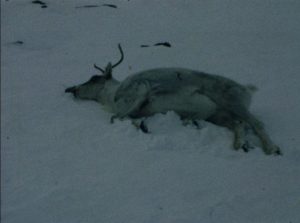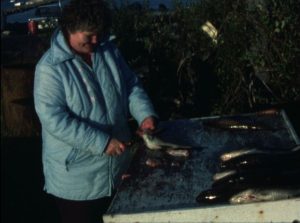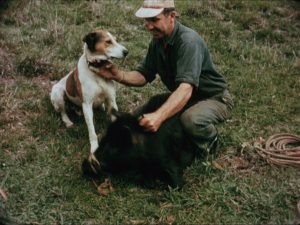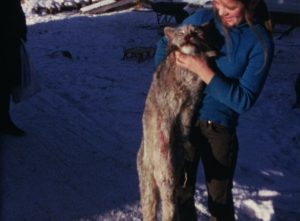
Caribou hunt, Labrador, Joan Cartledge Collection (1981)
By Emma Prichard, Northeast Historic Film
A caribou is shot, falls, and joins a dozen others ready to be cut up and hauled by snowmobile back to town. This scene is repeated several times throughout the Joan Cartledge Collection.

Cleaning fish, Labrador, Joan Cartledge Collection (ca. 1981)
Joan Cartledge was a missionary in Newfoundland and Labrador from 1972 to 1984. At a time when there were fewer roads between towns in the remote portions of Labrador, travel was limited to snowmobiles in winter, float planes in summer, and the occasional supply ship. In the remote communities of Postville, Makkovik, and Charlottetown, hunting provided a major food source. So, in amongst the footage of snowmobile rides and community events, are scenes of fishing, trapping, hunting, and a lot of dead animals.
Cataloger bias is something I try to keep in mind when I’m working. How much attention do I give the reels that are personally interesting to me, as opposed to others? But what happens when the cataloger is…squeamish? My viewing notes certainly become less detailed when I jump ahead a few minutes to avoid watching caribou being butchered.
The caribou are not the only animals featured in the Joan Cartledge Collection. We see shots of children inspecting dead bear and lynx. One scene includes a man cleaning a seal carcass on the shore. There is plenty of footage of people cutting up fish. All framed as part of a process, not as trophies.

Wild pig hunt, Hawaii, Mariette Hollins Collection (1963)
The Joan Cartledge Collection is one of several collections in The Women Behind the Camera project to feature the hunting and processing of animals into food. Other collections feature decoy hunting and target practice. One features a wild pig hunt in Hawaii, taking the viewer from preparation, to chase, through butchering, cooking, and finally a luau feast.
How to handle the censorship of our films, particularly of The Woman Behind the Camera Collection, is a frequent topic of conversation at NHF. Vault Manager and CLIR Project Director Karin Carlson-Snider spoke about the issue, including the Cartledge hunting scenes, at the 2017 AMIA Annual Conference. There are a couple ways of dealing with the potentially sensitive topic. One is to raise the audience rating when cataloging the film in Collective Access. The other is to put in a notice about the nature of the content within the record or on the website, along with the written description in the viewing notes. A final option would be editing out anything too graphic for online display, though this raises new questions about the integrity of the record, and so, is not done in cases of gore in the NHF collections.

Lynx, Labrador, Joan Cartledge Collection (1974)
I may have a difficult time watching these images, but that is not to say that it does not provide some amazing, up-close shots of the animals. What is disturbing to me is a normal part of life to others. The hunts serve a purpose, providing for communities, both in a form of sustenance and in a preservation of traditions. Deciding where to draw the line between providing access to these images, as they were originally meant to be seen, and shielding people from potentially disturbing content is a tricky distinction to make. One we try to make in as unbiased a way as possible.
